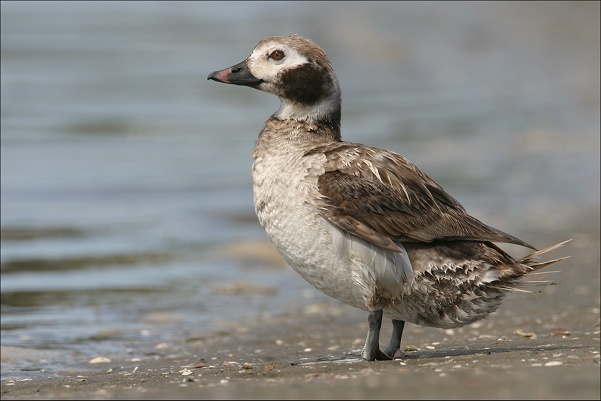
Location: Mission Bay (De Anza Cove), San Diego, CA
Date: 2005-04-10
Lens: Canon 500mm IS F4 + 1.4x II Converter

 Long-Tailed Duck
Clangula hyemalis
Long-Tailed Duck
Clangula hyemalis
 Description
DescriptionThe Long-tailed Duck, formerly known as Oldsquaw, is one of the deepest diving ducks. This bird has been caught in nets as deep as 200 feet (60 meters) below the surface. While most diving ducks propel themselves underwater using their webbed feet, the Long-tailed Duck uses its partially folded wings. During Winter these birds mainly feed on mollusks, shrimps, and crabs. While nesting they switch to roots, buds, and seeds.
General: 15 to 17 inches in length.
Adult Male Alternate: Black head, neck, chest, and back. White flanks, belly and undertail coverts. Dark wings. Long, black, slender central tail feathers. Large white patch around the eye. Pinkish bill. Plumage worn Spring through Summer. 19 - 22 inches in length.
Adult Male Basic: White crown, neck, back, flanks, and belly. Black chest and lower back. Grayish face patch. Black bill with pinkish pale patch towards tip. Dark wings. Long, black, slender central tail feathers. Plumage worn Fall through Winter.
Immature Male: White head and neck. Gray chest and back. Whitish flanks and belly. Dark crown and face patch. Black bill with pinkish pale patch towards tip. Dark wings. Short, black central tail feathers.
Adult Female: White head and neck. Gray back. White flanks and belly. Dark crown and face patch. Pale bill. Dark wings. Short tail. Plumage darker in summer.
Open bays and inshore waters in Winter. Breeds on tundra.
 Nesting
Nesting5-11 yellowish or cream-colored eggs. The eggs have a 24-29 day incubation period. Fledging occurs in 35-40 days. The nest is a cup of grass, lined with down, and concealed on the tundra near water.